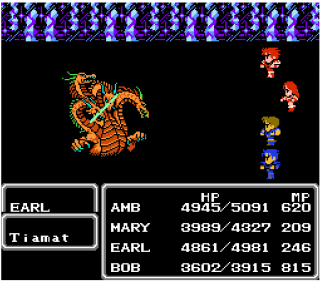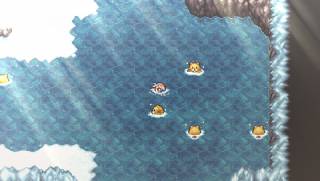Overview
 Battle from the Famicom version.
Battle from the Famicom version.Final Fantasy II is a sequel to Square's Final Fantasy and was only released in Japan on the Famicom in 1988. An English-language NES release was originally planned under the title "Shadow of Palamecia", but it was never completed. The game has since then been remade on various other platforms including the WonderSwan Color, PlayStation, PSP, Game Boy Advance and iPhone. The game does not share any connection with the original Final Fantasy's world or characters, establishing a precedent all entries in the primary Final Fantasy series have since followed.
Story
 Beavers are crucial to the story of Final Fantasy II.
Beavers are crucial to the story of Final Fantasy II.Final Fantasy II is about four heroes, including main protagonist Firion, who join a resistance group called Wild Rose and try to stop the Empire of Palamecia from taking over the world. The dialogue in Final Fantasy II is a lot more dynamic than the first; players can ask NPCs about key terms and items to advance the plot or unlock certain events. It is also the first Final Fantasy where party members can join and leave the party during the game. Final Fantasy II also introduced elements that have since become defining concepts of the Final Fantasy series. It is the first game to feature the chocobo, a mount that would let the player ride across the world without any random encounters, and a character named Cid.
Gameplay
 Battle scene from the PSP remake.
Battle scene from the PSP remake.Final Fantasy II's combat and character progression use different systems than were seen in the original game. Instead of gaining experience points to increase in level and raise stats across the board, the heroes gain skill levels for the attributes they use in battle. For example, if they use swords, their strength and sword skill will increase; if they get hit in battle, their hit points will increase.
A glitch in the Famicom version of the game registers canceled stat-boosting commands. If the player were to repeatedly input and cancel a particular command, they could conceivably give the related stats a substantial boost before the end of a single battle. This glitch was fixed in later ports.
Final Fantasy II also introduced the idea of party formation to the franchise. The player could move their characters to the back of the line in battle, reducing their chances of taking damage while limiting their own attack capabilities to using bows or magic.
Version Differences
As stated above, Final Fantasy II has seen numerous iterations since its conception. What follows below are the different versions released over the years and the iterative changes with each subsequent release.
Famicom (1988 and 1994)
The original Final Fantasy II was released for the Famicom in Japan and was set to release in North America supposedly with the subtitle Dark Shadow Over Palakia. With the looming release of the Super Nintendo and a long localization process, the 8-bit version never made its way outside of Japan despite the success of the first Final Fantasy and Square advertisements of the beta version. The Famicom version was re-released in Japan as part of a compilation with the first Final Fantasy in 1994. This version still remains exclusive to Japan despite Nintendo's claims that each pre-PlayStation Final Fantasy would be released over its Virtual Console service.
WonderSwan Color (2001)
More than a decade after Final Fantasy II's original release, Square decided to put support behind the WonderSwan Color, a Japan handheld gaming device. Along with this support came re-releases of Final Fantasies I, II and III, whose graphics were updated to suit the 16-bit handheld. The game also had fully drawn backgrounds for battle sequences and remastered audio. Final Fantasy II for the WonderSwan was a release title and was also featured in a limited edition bundle. The bundle included the game, a specially branded system and a premium strap with Final Fantasy II branding.
PlayStation (2002 and 2003)
Nearly 15 years later, gamers outside of Japan could purchase a version of Final Fantasy representative of their own territory. The PlayStation version added CG cutscenes and featured technical improvements beyond that of the WonderSwan Color version. It was released separately or compiled in Japan and released solely as the compilation Final Fantasy Origins overseas.
Mobile Phones (2004 and 2006)
Due to the immense popularity of cell phone gaming in Japan, a mobile phone version was released over three services providers on different dates. The graphics and sound most closely resemble that of the more widely known Game Boy Advance version. This version remains exclusive to Japan.
Game Boy Advance (2004)
This version of Final Fantasy II signaled Square's returning support for Nintendo handhelds as well as Final Fantasy II's first official release in the Australia territory. Released under the compilation Final Fantasy I & II: Dawn of Souls, the reworked title also featured a new post-game sequence called Souls of Rebirth, in which players can control the various support characters that died during the main storyline.
PlayStation Portable (2007 and 2008)
To commemorate the 20th anniversary of the Final Fantasy series, Square-Enix brought Final Fantasy II out of the vault once more for the release of Final Fantasy II Anniversary Edition. It is considered as the ultimate version of Final Fantasy II as it includes all the bonuses from previous versions as well as updated graphics and sound, a rebalanced combat system and two extra dungeons.
iPhone (2010)
The iPhone version retains all aspects of the PSP anniversary release. The only main difference between the two versions is the method of control. Whereas the PSP utilizes digital button inputs, the iPhone version is controlled solely by its touch screen interface.
Soundtrack
The original soundtrack was composed by Nobuo Uematsu. The remakes of the game have sound produced and arranged by Tsuyoshi Sekito.
PlayStation track listing:
1. "Opening Movie"
2. "Opening Movie SE"
3. "Opening Theme"
4. "Prelude"
5. "Battle Scene 1"
6. "Time of Revival"
7. " Reunion"
8. "Rebel Army Theme"
9. "Town"
10. "Main Theme"
11. "Pandemonium Castle"
12. "Imperial Army Theme"
13. "Chocobo's Theme"
14. "Tower of Magic-users"
15. "Escape!"
16. "Ancient Castle"
17. "Dungeon"
18. "Emperor's Revival"
19. "Victory"
20. "Waltz"
21. "Temptation of the Princess"
22. "Dead Music"
23. "Fanfare"
24. "Include in the Group"
25. "Inn"
26. "Battle Scene A"
27. "Battle Scene B"
28. "Battle Scene 2"
29. "Finale"
Log in to comment